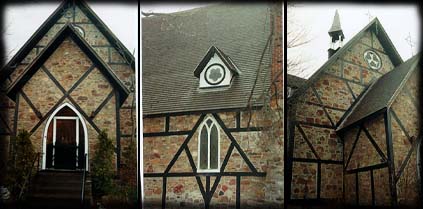|
|
The history of the Fauquier Memorial Chapel is as much the story of the man it commemorates than it is of any actual building. The Bishop's history is a simple one, as is the chapel's, and yet both man and church brought change to Sault Ste. Marie and the Diocese of Algoma. In their way, both are important to the history of this city. Frederick Dawson Fauquier was elected the first Bishop of Algoma in Toronto and was consecrated in September of 1873. Within three weeks of his consecration Fauquier hurried to England and gained the support of the three great missionary societies as well as several wealthy individuals to aid the infant Diocese. He stayed for five months and finally he arrived at the Sault in the spring or summer of 1874. With the money he had obtained Fauquier was able to build "Bishophurst" and begin to work within the Diocese of Algoma. He worked out an annual schedule which he followed closely until his death. Fauquier spent the months of May until November in the Sault, visiting, and preaching in all areas of the Diocese. In the remainder of the year he operated out of Toronto, devoting the period of January through March for a thorough visitation in Muskoka since many settlements in that region were more accessible in the winter. One of Fauquier's most beloved projects was the upkeep of the two Indian schools established in the 1870's: Wawanosh - for girls, and Shingwauk School for boys. The Shingwauk School had been built east of the city (and it is now Algoma College) on land the Diocese had purchased from Reverend Wilson, the priest in charge of St. Lukes Church. The Crown had originally granted the 41 acres to John MacPherson Hamilton on the 23rd of September, 1874. Reverend E. Wilson bought the property from Hamilton on the 26th of June, 1874, for $250. On the 8th of February, 1875, the Diocese of Algoma purchased the land from Wilson in the name of Bishop Fauquier and his successors. The Shingwauk School was opened on this site soon after. Fauquier's interest in raising funds for these schools can be seen in his diaries where he carefully recorded each donation received. Another of Fauquier's projects was to build a small chapel on the grounds of the Shingwauk School for the use of the Indian boys. By 1881 Fauquier had chosen the site for the chapel and the plans for its construction. On July 1, 1881, Fauquier outlined the perimeter of the proposed chapel and dedicated the site to the worship of God.
Fauquier never lived to see the chapel built. He and his wife both died in 1881 and the next spring they were both buried on the Shingwauk grounds. The "Algoma Missionary News and Shingwauk Journal", after relating the Bishop's funeral, commented on the lack of funds for the chapel which was now to be dedicated to Fauquier. The windows had been promised, and the pulpit and seats were already made, but there was still no money to begin construction. The $1500 needed to begin construction, arrived, as on May 1, 1883 the same journal published a list of items needed to furnish the chapel, and gave a description of how the work was proceeding.
On July 1, 1883, the Journal gave the first description of the Memorial Chapel.
The chapel was built under the supervision of the Reverend E. F. Wilson who worked under Fauquier. Reverend Wilson was in fact the architect and designer of the chapel "to the last minute detail". The chapel was consecrated on the 29th of August, 1883, by Bishop Sullivan, and was reported on by the Algoma Missionary News. The journal also commented on the nearly completed interior. Upon entering the chapel you see:
The exterior of the chapel has remained unaltered during the 94 years it has stood. The grounds around it have changed. The Anglican Church now only owns the land surrounding the chapel, the cemetery and a house on the Algoma College grounds. The Fauquier Memorial Chapel is now the only surviving building of the original Shingwauk School. The school was torn down in 1934 and replaced by the present structure in 1935. The building and surrounding grounds are now part of Algoma College. The other major change was the extension of Queen Street East which now runs past the chapel, directly outside its door. This has destroyed the quiet, "rustic" charm of the church but has done no physical damage to the building. 
|

